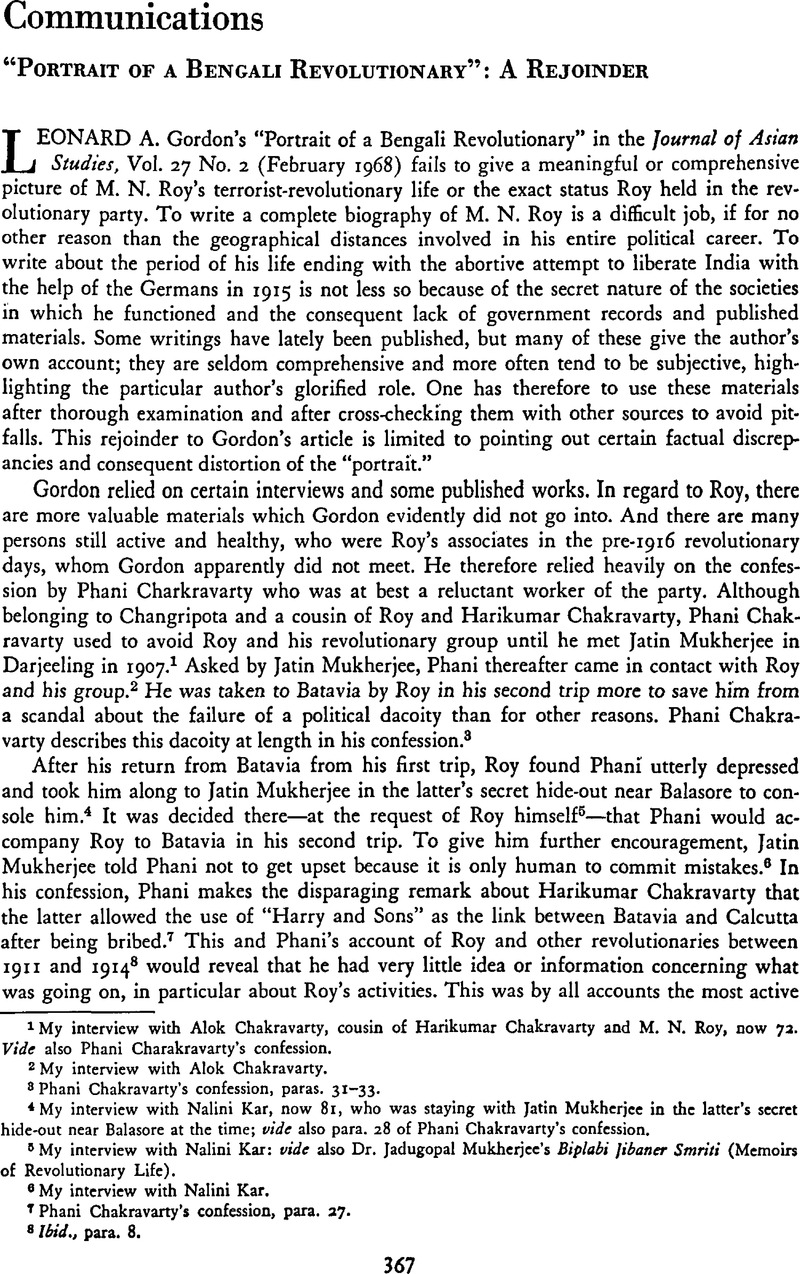No CrossRef data available.
Published online by Cambridge University Press: 23 March 2011

1 My interview with Alok Chakravarty, cousin of Harikumar Chakravarty and M. N. Roy, now 72. Vide also Phani Charakravarty's confession.
2 My interview with Alok Chakravarty.
3 Phani Chakravarty's confession, paras. 31–33.
4 My interview with Nalini Kar, now 81, who was staying with Jatin Mukherjee in the latter's secret hide-out near Balasore at the time; vide also para. 28 of Phani Chakravarty's confession.
5 My interview with Nalini Kar: vide also Dr. Jadugopal Mukherjee's Biplabi Jibaner Smriti (Memoirs of Revolutionary Life).
6 My interview with Nalini Kar.
7 Phani Chakravarty's confession, para. 27.
8 Ibid., para. 8.
9 My interview with Nirvan Swami, formerly Satish Sarkar, now 85, one of the accused in the Howrah Gang case. Absconded and conducted the case on behalf of the accused.
Also: interviewed by me, Pundit Laxman Shastri Joshi Tarkateertha, said that Roy had told him about this failure of mission to pursuade Aurovindo to return to politics.
10 My interview with Lalit Bhattacharya, younger brother of M. N. Roy.
11 My interview with Kali Charan Ghosh of Changripota, now 75, author of “The Roll of Honour.”
12 Harikumar writes: “At the cross-road of our lives (in 1905) when we were restless to do something, to find out a path, we received a copy of the revolutionary journal, Sandhya, (founded and edited by Brahmabandhav Upadhyaya). … About the same time, Kedarnath Babu, (uncle of Saileswar Bose, who ran the shop, Universal Emporium, at Balasore in 1915), who was a member of the Vivekananda Society gave us Vivekananda's book, Karma Yoga. We read Swamiji's message: ‘it is better to be attached than to be unattached.’ We were greatly excited. We had no sleep that night. Thereafter we read Swamiji's ‘Present India.’ We had then decided our course of life. Swamiji's philosophy of life provided us the guidelines. Vivekananda's words rang the bells in us. Hence food for thought came from his words. We began to sing his songs and chant his message: sacrifice.” (Viswa-Viveka, page 254).
13 My interview with Alok Chakravarty.
14 My interview with Lalit Bhattacharya.
15 Harikumar Chakravarty—“In Memory of Manabendranath,” Bengali pamphlet, Calcutta 1954, page 6.
16 M. N. Roy—New Orientation, Calcutta, page 198.
16A Interview with Alok Chakravarty and Nripen Chakravarty, another nephew of Harikumar Chakravarty and M. N. Roy.
17 Dr. Jadugopal Mukherjee—Biplabi Jibaner Smriti (Memoirs of Revolutionary Life), page 336.
18 Ibid., page 336.
19 My interviews with Satish Chakravarty, Monoranjan Gupta and Dr. Aswini Roy.
20 My interview with Dr. Asini Roy, now 85.
21 Interview with Alok Chakravarty.
22 Interview with Satish Chakravarty and also Dr. Aswini Roy.
23 Harikumar Chakravarty—“In Memory of Manabendranath,” page 7.
24 Dr. Bhupen Dutt—Aprokasito Rajnaitik Itihas (Unpublished History of Hindia) page 255.
25 My interviews with Satish Chakravarty and Amar Krishna Ghosh.
26 Barindra Kumar Ghosh—Agni Yuga (Revolutionary Age), page 125.